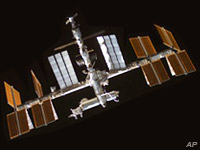
NASA on Wednesday shut off one of the two external cooling loops on the International Space Station and has been struggling to fix it since.
The problem appears to be in the flow valve within a pump module.
There has been speculation that the situation could be more serious than NASA has acknowledged. Some noncritical systems in various nodes and laboratories have been powered down, and mission managers have put off a decision on whether to proceed with the Dec. 18 launch of the Orbital Sciences’ Cygnus commercial cargo craft.
However, neither the crew of six nor the station itself are in danger, NASA spokesperson Joshua Buck told TechNewsWorld.
“Teams are working to evaluate exactly what caused the problem and how to fix it,” Buck explained, adding that several options are on the table but none had yet been selected.
“With situations such as this, it’s critical to have a good understanding of what went wrong or identify a list of possibilities and, based on that, come up with a repair plan,” noted Jekan Thanga, an assistant professor at the School of Earth and Space Exploration at Arizona State University.
What Happened
The station has two external cooling loops. These circulate ammonia outside the station to keep both internal and external equipment cool.
The pump module on one of these automatically shut down when it began overheating.
The flow control valve that’s suspected of malfunctioning regulates the temperature of the ammonia in the loop so that when the ammonia is fed back into the heat exchanger on the station’s Harmony module, it does not freeze the water that’s also flowing through the exchanger.
Ground control teams moved some electrical systems over to the second loop and powered down some noncritical systems inside the Harmony node and the Kibo and Columbus laboratories.
The loops cool down the ISS solar panels to ensure they generate electricity without overheating, ASU’s Thanga told TechNewsWorld.
“Problems such as this are typically not very serious,” he pointed out. NASA shut off nonessential activity on the station because “improper use could result in the panel getting overheated and degrading performance in providing electricity to the station.”
A failed external cooling loop pump had to be replaced in 2010, said Thanga.
What We Now Know
It’s now believed the valve is positioned incorrectly and that is what caused the pump malfunction.
Overnight on Thursday, flight controllers on the ground tried to power cycle the starboard (right side) truss pump module to reposition the valve, but that effort failed.
The engineering teams have concluded the valve’s firmware cannot be modified to help fix the problem, and they will look into whether the thermal loop can be warmed by other methods, such as manipulating other valves in the system or heating up the system.
Meanwhile, station program managers will discuss the possibility of having to conduct multiple spacewalks to replace the pump module. They might begin late next week.
“If they choose to conduct a spacewalk, it is one that the crew have trained extensively for, so they are well prepared,” NASA’s Buck said.
Spacewalks can be time-consuming and difficult, and “part of an effective mitigation strategy is to minimize unnecessary spacewalks and ensure speedy repair,” ASU’s Thanga noted.
Swanning About
Kenny Todd, chairman of the ISS Mission Management Team, has postponed until Monday a decision on whether to launch the Cygnus unmanned resupply spacecraft, said Buck.
This will give the station and ground crews more time to work on the flow valve problem.
If the Cygnus launch is delayed, Buck said, “the crew is well provisioned and will not be in any danger of dwindling supplies.”





















































